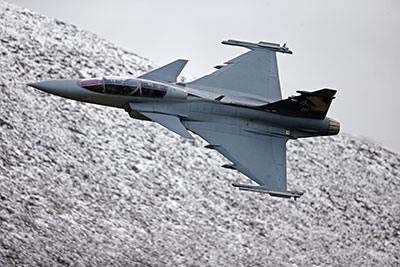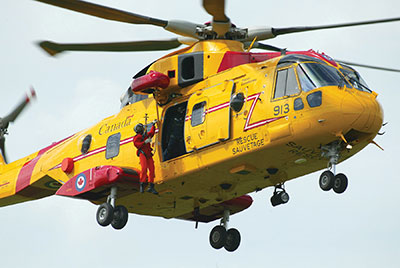
Features
Operations
Maintaining a strong position
Although the defence sector is not expected to perform as well as the commercial aviation side of the market this year
May 7, 2014 By Brian Dunn
Although the defence sector is not expected to perform as well as the commercial aviation side of the market this year, defence spending in emerging markets should offset reduced spending in the United States and Europe, according to a leading industry analyst.
 |
|
| Héroux-Devtek’s new acquisition APPH produces landing gear for the SAAB JAS Gripen, a lightweight single-engine multirole fighter aircraft. Photo: SAAB
|
The weaker Canadian dollar should also boost the fortunes of all of Canada’s aerospace companies whose main operations are based domestically but whose products and services are priced in U.S. dollars, said Cameron Doerksen of the National Bank Financial in Montreal.
“Our top pick in the sector is CAE as it will benefit the most from the positive outlook for the large commercial aerospace sector, capacity growth from the global airlines, an increase in business jet utilization and from improving sentiment for defence.
“Although its large defence exposure will represent a headwind in the near term, we also like Héroux-Devtek as it too will benefit from higher production rates for large commercial aircraft and from the ramp-up of new business jet programs in the coming years.”
The decrease in U.S. military spending and repair activity was reflected in Héroux’s third-quarter results which saw a net profit from continuing operations of $2.6 million, compared with $3.2 million during the year-earlier period. Sales were down marginally to $61.4 million from $61.7 million.
While sales to the commercial market increased 3.2 per cent to $28.5-million in the quarter, sales to the military sector declined 3.4 per cent to $33-million on reduced repair and overhaul activity, lower spare parts requirements (mostly on the B-2 and F-15 programs) and reduced electronic enclosure and cabinet sales at its Magtron aerostructure products division.
The lower military sales reflect a weak U.S. market due to reduced defence budget funding and sequestration measures, the company said. However, there was some positive offset from new business with Boeing Co. on the CH-47 Chinook helicopter program, the company added.
Héroux cautioned that the military market is expected to “remain challenging and the situation could affect the corporation beyond the current fiscal year, despite having a diversified military portfolio, balanced between new component manufacturing and aftermarket products and services that should lessen this impact.”
CAE reported its third-quarter results a few days later and revealed a net profit of $47.6 million for the period, up from $37.2 million a year earlier. Sales rose to $513.6 million from $500.9 million. Commercial sales rose three per cent to $282.1 million from $273.4 million.
On the military side, operating income increased 22 per cent to $31 million, from $25.4 million a year ago, as revenue grew two per cent to $201.8 million. It received $240.3 million in military orders. Military simulation products and training operating income increased, but a 26.5 per cent growth in training revenues more than offset nine per cent decrease in products revenues.
“We booked orders during the quarter for simulators, upgrades and services for enduring aircraft platforms including the MH-60R Seahawk helicopter for the Royal Danish Navy, the P-8A Poseidon aircraft for the U.S. Navy and the C-130 Hercules aircraft for the U.S. Air Force,” noted Marc Parent, president and CEO of CAE. “On new aircraft programs for CAE, we signed contracts for a comprehensive ground-based training system on the T-6C aircraft for the Mexican Air Force, an Unmanned Aerial System Mission Trainer for the General Atomics Predator for the Italian Air Force, and aircrew training services for the T-44C Pegasus for the U.S. Navy.
“We see more clarity in the U.S. now that they have this bipartisan budget about which programs are being funded and which are not. And luckily, the programs that are being funded are ones in which we have a good position. And in this environment of budget cuts, what better way is there to maintain training than through simulation?”
In total, CAE received $240.3 million in combined military segment orders during the third quarter, while its military backlog stood at $2 billion.
Héroux-Devtek is getting more heavily involved in the defence sector with its recent US$124-million acquisition of British-based landing-gear company APPH Limited, its first acquisition outside North America, and U.S.-based APPH Wichita Inc., subsidiaries of BBA Aviation PLC. The deal includes four plants in Britain and one plant in Wichita, Kan., and will add about 400 employees to Héroux’s workforce of about 1,000 in North America and $77 million in revenue to Héroux’s own $250 million in annual sales. In addition, APPH has an order backlog of about $80 million, according to Héroux.
APPH produces landing gear for the BAE Systems Hawk single-engine advanced jet trainer, the SAAB JAS Gripen, lightweight single-engine multirole fighter aircraft and the Alenia C-27J Spartan medium-sized military transport aircraft.
It also produces landing gear for the AgustaWestland AW101, a medium-lift helicopter used in both military and commercial applications and the Airbus Helicopter’s EC175, a 7-ton class medium utility helicopter in development.
“The acquisition of APPH brings significant and immediate strategic benefits to Héroux-Devtek, while strengthening its global competitive position and status as a leading landing gear system provider for aircraft weighing less than 100,000 pounds,” said Gilles Labbé, president and CEO of Héroux Devtek..
“APPH expands our geographical footprint into the European market, provides us with significant content on several leading aircraft programs, further increases and diversifies our customer base and provides greater exposure to the attractive aftermarket business.” The deal also gives Héroux-Devtek an enhanced presence in the lucrative proprietary rights field.
The company was recently rewarded a contract to supply the complete landing-gear assembly set for the Boeing 777. That contract, in addition to the sub-assemblies for the Lockheed Martin F-35 fighter jet, will substantially boost Héroux’s own line of propriety technologies.
Proprietary products are conceived and designed in-house and command higher prices and better margins and generate more after-sales business. A company that buys such products depends on a continuing supply from the same manufacturer for repairs and renewal of its aircraft.
The acquisition of APPH will increase Héroux’s overall proprietary products to 25 per cent of revenues from the current 11 per cent, according to Labbé, while the company’s revenue mix is expected to be 54 per cent military and 46 per cent commercial.
 |
|
| APPH, a subsidiary of Héroux-Devtek, makes the landing gear for the AgustaWestland AW101. Photo: RCAF
|
Analyst Benoit Poirier of Desjardins Securities called the US$124-million price “fair” as APPH is expected to contribute immediately to Héroux’s top and bottom lines. Last year, the company divested itself of its aero-structure division for $300 million to concentrate on its core expertise in landing-gear systems.
Doerksen called the deal “a bold step forward that will materially increase Héroux’s size and cements the company’s position as the clear number three landing-gear player worldwide,” behind Goodrich Co. and Messier-Bugatti-Dowty. It should also boost revenues by about 33 per cent with little overlap with Héroux’s existing programs, since North America only represents some 23 per cent of APHH’s sales. Half of its sales are generated in the U.K. and another 20 per cent in Europe.
But one of Doerksen’s biggest concerns for both Héroux and CAE is the importance of the defence market to their bottom lines. “We believe that increased visibility on U.S. defence spending will help improve the sentiment towards companies with large exposures to defence. Late in 2013, an agreement was reached on U.S. defence spending over the next two years. Under the deal, defence spending will be capped at about $498 billion in 2014, $29 billion less than what was requested, but $21 billion above the original sequester level. For 2015, spending is capped at $521 billion, about $9 billion above the previous $512 billion cap.”
For several years, the Pentagon has been working under a resolution funding mechanism, which disallows new procurement programs from starting or the rewarding of new multi-year programs, Doerksen noted. But the new defence spending deal may help speed up the procurement process, he added.
And while the U.S. and European defence markets aren’t growing, other markets are seeing growth. Japan, for example, announced plans to increase its defence budget by five per cent over the next five years to counter a more aggressive Chinese foreign policy.
Other Asian countries are likewise increasing defence spending, while some countries in the Middle East are “aggressively procuring new aircraft and other weapons systems,” said Doerksen. As a result, “we think that CAE is particularly well positioned to continue to expand its presence in both Asia and the Middle East.”
But with lower procurement spending in the U.S., some industry watchers believe consolidation in the defence sector will pick up steam, although the analyst doesn’t believe CAE or Héroux-Devtek are likely takeover targets. Instead, both could be going after targets themselves.
While the defence sector represents some 40 per cent of CAE’s business, it’s unlikely to see much growth this year, said Doerksen. But the increased visibility on U.S. defence spending will improve “stability” in the sector. And while the military market remains challenging, Héroux’s cost structure in the defence sector should improve by the closure of a facility in Longueuil, QC.